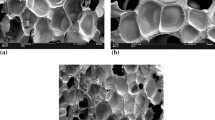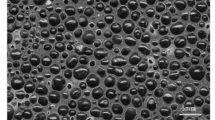Abstract
The dynamic compressive stress-strain behavior of a rigid polyurethane foam with four values of density (78, 154, 299, and 445 kg/m3) has been determined in the strain-rate range of 1000–5000 s−1. A pulse shaping technique was used with a split Hopkinson pressure bar to ensure homogeneous deformation in the foam specimens under dynamic compression. Dynamic stress equilibrium in the specimen was monitored during each experiment using piezoelectric force transducers mounted close to the specimen end-faces. Quasi-static experiments were also performed to demonstrate rate effects. Experimental results show that both the quasistatic and the dynamic stress-strain curves of the foam exhibit linear elasticity at small strains until a peak is reached. After the peak, the stress-strain curves have a plateau region followed by a densification region. The peak stress is strain-rate sensitive and depends on the square of the foam density.
Similar content being viewed by others
References
Ashe, W.A., “Rigid Cellular Plastics in Automotive Applications,”ASTM Standard News,16 (10),32–33 (1988).
Yu-Hallada, L.C., Kuczynski, E.T., and Weierstall, M., “Polyurethane: The Material of Choice for Occupant Protection and Energy Management,” in Proceedings of Polyurethanes 1995, Chicago, IL, Sept. 26–29, Society of the Plastic Industry, 390–396 (1995).
Weiser, E.S., Johnson, T.F., Clair, T.L.S., Echigo, Y., Kaneshiro, H., andGrimsley, B.W., “Polyimide Foams for Aerospace Vehicles,”High Performance Polymers,12 (1),1–12 (2000).
Gibson, L.J. and Ashby, M.F., Cellular Solids, Structure and Properties, Second Edition, Cambridge (1999).
Kraynik, A.M., Neilsen, M.K., Reinelt, D.A., andWarren, W.E., “Foam Micromechanics,”in Foams and Emulsions, Eds., J.F. Sadoc andN. River, Kluwer Academic Publishers, Netherlands (1999).
Zhang, J., Kikuchi, N., Li, V., Yee, A., andNusholtz, G., “Constitutive Modeling of Polymeric Foam Material Subjected to Dynamic Crash Loading,”International Journal of Impact Engineering,21 (5),369–386 (1998).
Kipp, M.E., Chhabildas, L.C., Reinhart, W.D., andWong, M.K., “Polyurethane Foam Impact Experiments and Simulations,”in APS Shock Compression of Condensed Matter—1999, June 27–July 2, Snowbird, UT, APS (1999).
Schumacher, W., “Polyurethane Foams to Improve Shock Absorption and Assembly of New Bumper Systems” in Proceedings of Polyurethanes World Congress 1987: 50 Years of Polyurethanes, Aachen, Germany, Sept. 29–Oct. 2, Technomic Publishing Company, 248–251 (1987).
Sounik, D.F., Gansen, P., Clemons, J.L., andLiddle, J.W., “Head-Impact Testing of Polyurethane Energy-Absorbing (EA) Foams,”SAE Transactions: Journal of Materials & Manufacturing,106 (5),211–220 (1997).
Goods, S.H., Neuschwanger, C.L., Henderson, C.C., andSkala, D.M., “Mechanical Properties of CRETE, a Polyurethane Foam,”Journal of Applied Polymer Science,68 (7),1045–1055 (1998).
Lankford, J. andDannemann, K.A., “Strain Rate Effects in Porous Materials,”Porous and Cellular Materials for Structural Applications, Materials Research Society, Pittsburg, PA, 103–108 (1998).
Progelhof, R.C., “Impact Measurement of Low-Pressure Thermoplastic Structural Foam,” In Proceedings of Instrumented Impact Testing of Plastics and Composite Materials, Houston, TX, March 11–12, ASTM, 105–116 (1986).
Chou, C.C., Zhao, Y., Lim, G.G., andG.S. Song, “A Constitutive Model for Polyurethane Foams with Strain-Rate and Temperature Effects,”SAE Transactions: Journal of Materials & Manufacturing 107,743–754 (1998).
Chen, W., Zhang, B., andForrestal, M.J., “A Split Hopkinson Bar Technique for Low-Impedance Materials,” EXPERIMENTAL MECHANICS,39 (2),81–85 (1999).
Chen, W., Lu, F., andZhou, B., “A Quartz Crystal Imbedded Split Hopkinson Bar for Soft Materials,” EXPERIMENTAL MECHANICS,40 (1),1–6 (2000).
Karnes, C.H. andRipperger, E.A., “Strain Rate Effects in Cold Worked High-Purity Aluminum,”Journal of the Mechanics and Physics of Solids,14,75–88 (1966).
Wasley, R.J., Hoge, K.G., andCast, J.C., “Combined Strain Gauge-Quartz Crystal Instrumented Hopkinson Split Bar,”The Review of Scientific Instruments,40,889–894 (1969).
Togami, T.C., Baker, W.E., andForrestal, M.J., “A Split Hopkinson Bar Technique to Evaluate the Performance of Accelerometers,”Transaction of the ASME, Journal of Applied Mechanics,63,353–356 (1996).
Valpey-Fisher, The User's Guide to Ultrasound & Optical Products, Valpey-Fisher, Hopkinton, MA (1996).
Duffy, J., Campbell, J.D., andHawley, R.H., “On the Use of Torsional Hopkinson Bar to Study Rate Effects in 1100-0 Aluminum,”Journal of Applied Mechanics,38,83–91 (1971).
Ravichandran, G. andChen, W., “Dynamic Behavior of Brittle Materials Under Uniaxial Compression,”in Experiments in Micromechanics of Fracture Resistant Materials, Ed., K.S. Kim, AMD-130, ASME, New York, 85–90 (1991).
Nemat-Nasser S., Isaacs, J.B., andStarrett, J.E., “Hopkinson Techniques for Dynamic Recovery Experiments,”Proceedings of the Royal Society of London A 435, 371–391 (1991).
Kolsky, H., “An Investigation of Mechanical Properties of Materials at Very High Rates of Loading,”Proceedings of the Physics Society of London, Series B,62,676–700 (1949).
Lindholm, U.S., “Some Experiments with the Split Hopkinson Pressure Bar,”Journal of Mechanics and Physics of Solids,12,317–335 (1964).
Follansbee, P.S. andFrantz, C., “Wave Propagation in the SHPB,”J. Eng. Mater. Technol. (Trans. ASME),105,61–66 (1983).
Gray, G.T., III, Blumenthal, W.R., Trujillo, C.P., andCarpenter, R.W., II, “Influence of Temperature and Strain Rate on the Mechanical Behavior of Adiprene L-100,”Journal de Physique IV France Colloq. C3 (DYMAT 97),7,523–528 (1997).
Wu, X.J. andGorham, D.A., “Stress Equilibrium in the Split Hopkinson Pressure Bar Test,”Journal de Physique IV France Colloq. C3 (DYMAT 97),7,91–96 (1997).
Gong, J.C., Malvern, L.E., andJenkins, D.A., “Dispersion Investigation in the Split Hopkinson Pressure Bar,”J. Eng. Mater. Technol. (Trans. ASME),112,309–314 (1990).
Gary, G., Klepaczko, J.R., and Zhao, H., “Corrections for Wave Dispersion and and Analysis of Small Strains with Split Hopkinson Bar,” Proceedings of the International Symposium of Impact Engineering, Sendai, Japan, 73–78 (1992).
Lifshitz, J.M. andLeber, H., “Data Processing in the Split Hopkinson Pressure Bar Tests,”Int. J. Impact Engng.,15 (6),723–733 (1994).
Sawas, O., Brar, N.S., andBrockman, R.A., “Dynamic Characterization of Compliant Materials Using an All-polymeric Split Hopkinson Bar,” EXPERIMENTAL MECHANICS,38 (3),204–210 (1998).
Bacon, C., “An Experimental Method for Considering Dispersion and Attenuation in a Viscoelastic Hopkinson Bar,” EXPERIMENTAL MECHANICS,38 (4),242–249 (1998).
Chen, W. andZhou, B., “Constitutive Behavior of Epon 828/T-403 at Various Strain Rates,”Mechanics of Time-Dependent Materials,2,103–111 (1998).
Author information
Authors and Affiliations
Rights and permissions
About this article
Cite this article
Chen, W., Lu, F. & Winfree, N. High-strain-rate compressive behavior of a rigid polyurethane foam with various densities. Experimental Mechanics 42, 65–73 (2002). https://doi.org/10.1007/BF02411053
Received:
Revised:
Issue Date:
DOI: https://doi.org/10.1007/BF02411053




